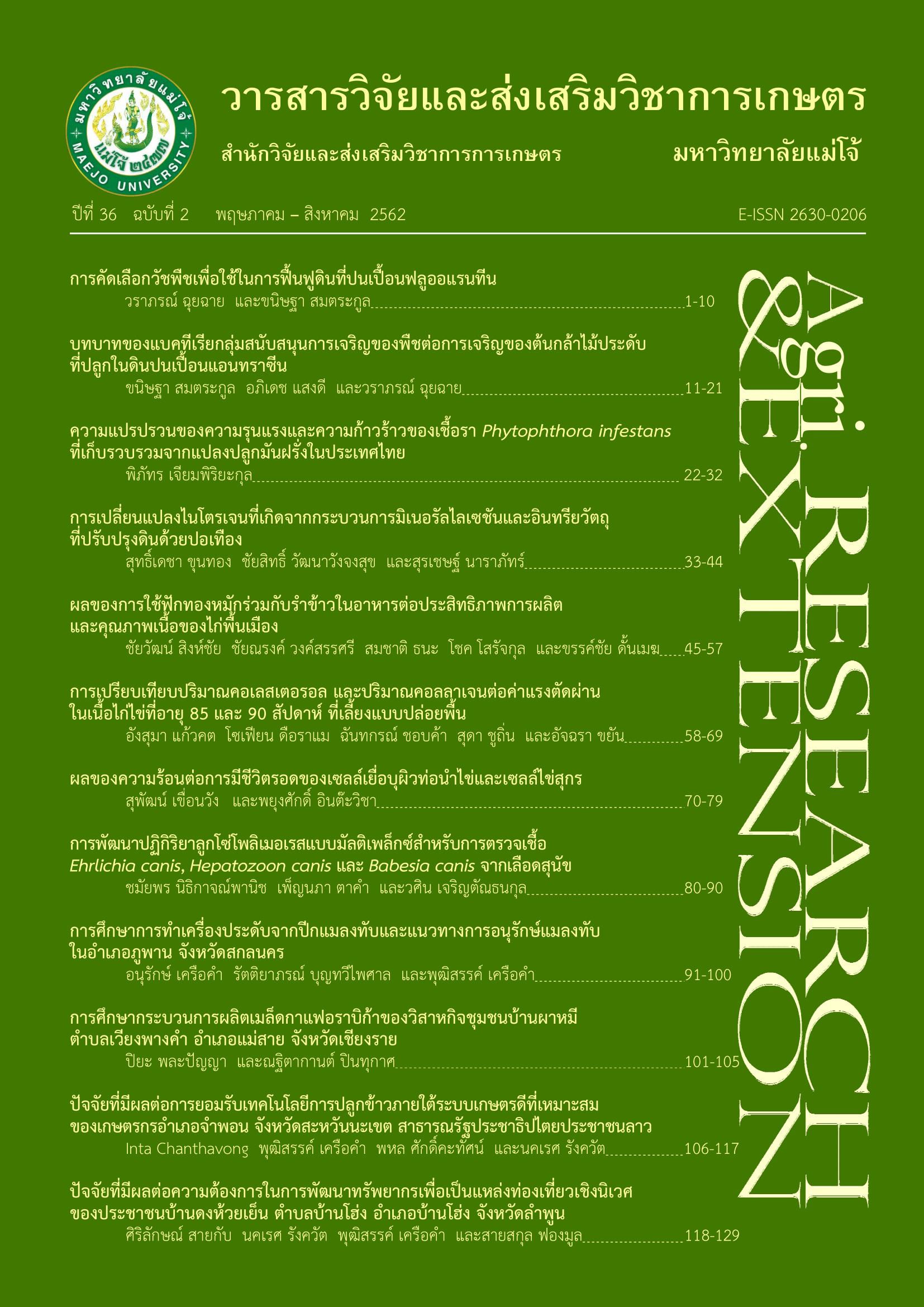การเปลี่ยนแปลงไนโตรเจนที่เกิดจากกระบวนการมิเนอรัลไลเซชัน และอินทรียวัตถุที่ปรับปรุงดินด้วยปอเทือง
คำสำคัญ:
ไนโตรเจน, มิเนอรัลไลเซชัน, ปอเทือง, ชุดดินลำปางบทคัดย่อ
ศึกษากระบวนการไนโตรเจนมิเนอรัลไลเซชันจากชิ้นส่วนปอเทืองต่อการเปลี่ยนแปลงปริมาณอินทรียวัตถุ และอนินทรีย์ไนโตรเจนในดินแต่ละช่วงเวลา วางแผนการทดลองแบบสุ่มสมบูรณ์ จำนวน 4 ซ้ำ มี 6 สิ่งทดลอง ได้แก่ การบ่มดินตำรับควบคุม (T1) การใช้ส่วนราก (T2), ลำต้น (T3), ใบ (T4), ดอก (T5), และส่วนราก+ลำต้น+ใบ+ดอก (T6) ของปอเทืองสด จำนวน 1.6 กรัม บ่มในภาชนะที่บรรจุดิน 100 กรัม (อัตรา 5,000 กก./ไร่) ที่ระยะเวลาการบ่ม 10, 20, 40, 60, 80, 100 และ 120 วัน ทำการทดลองในห้องปฏิบัติการอุณหภูมิเฉลี่ย 25°ซ และรักษาความชื้นของดินที่ระดับ 50 เปอร์เซ็นต์ โดยน้ำหนัก ตลอดระยะเวลาการทดลอง พบว่าส่วนของดอกมีกระบวนการไนโตรเจนมิเนอรัลไลเซชันสูงที่สุด รองลงมา คือ ส่วนของใบ และส่วนราก+ลำต้น+ใบ+ดอก พบปริมาณสูงสุดที่ระยะเวลา 60 วัน มีกระบวนการไนโตรเจนมิเนอรัลไลเซชัน 167.13, 79.13 และ 66.89 มก./กก. ตามลำดับ ถัดมา คือ ส่วนของราก และลำต้นพบปริมาณสูงสุดที่ระยะเวลา 80 วัน แต่ไม่พบความแตกต่างอย่างมีนัยสำคัญทางสถิติระหว่างกัน มีกระบวนการไนโตรเจนมิเนอรัลไลเซชัน 44.12 และ 42.00 มก./กก. ตามลำดับ เมื่อพิจารณาในภาพรวมกระบวนการไนโตรเจนมิเนอรัลไลเซชันจากต้นปอเทือง ในพื้นที่ 1 ไร่ ที่ระยะเวลา 60 วัน เทียบเท่าการใช้ปุ๋ยยูเรีย 45.37 กก. การใช้ปอเทืองสามารถเพิ่มปริมาณอินทรียวัตถุได้สูงสุด 1,382.37 กก./ไร่ อย่างไรก็ตามปริมาณคาร์บอน และปริมาณอินทรียวัตถุมีความผันแปรตามระยะเวลา ผกผันกับกระบวนการไนโตรเจนมิเนอรัลไลเซชัน
เอกสารอ้างอิง
Abbasi, M.K., M.M. Tahir, N. Sabir and M. Khurshid. 2015. Impact of the addition of different plant residues on nitrogen mineralization–immobilization turnover and carbon content of a soil incubated under laboratory conditions. Solid Earth 6: 197-205.
Abera, G., E. Wolde-meskel and L.R. Bakken. 2012. Carbon and nitrogen mineralization dynamics in different soils of the tropics amended with legume residues and contrasting soil moisture contents. Biology and Fertility of Soils 48: 51-66.
Abiven, S., S. Recous, V. Reyes and R. Oliver. 2005. Mineralisation of C and N from roots, stems and leaves residues in soil and role of their biochemical quality. Biology and Fertility of Soils 42: 119-128.
Aumtong, S. and P. Pongwongkam. 2017. The amount and sequestration of organic carbon fractions in paddy soils. Journal of Agricultural Research & Extension 34: 1-13. [in Thai]
Brady, N.C. 1984. The Nature and Properties of Soils. New York: Macmillan Publishing. 750 p.
Bremner, J.M. and D.R. Keeney. 1966. Determination and isotope-ration analysis of different forms of nitrogen in soil: exchangeable ammonium, nitrate and nitrite by extraction distillation methods. Soil Science Society of America Journal 30: 577-583.
Delve, R.J., G. Cadisch, J.C. Tanner, W. Thorpe, P.J. Thorne and K.E. Giller. 2001. Implications of livestock feeding management on soil fertility in the smallholder farming systems of sub-Saharan Africa. Agriculture Ecosystems & Environment 84: 227-243.
Folin, O. and W.A. Denis. 1915. A Colorimetric method for the determination of phenols (and phenol derivatives) in urine. Journal of Biological Chemistry 22: 305-308.
ISO 10694. 1995. Soil Quality-determination of Organic and Total Carbon after Dry Combustion (Elementary Analysis). International Standard. 7 p.
ISO 13878. 1998. Soil Quality-determination of Total Nitrogen Content by Dry Combustion (Elemental Analysis). International Standard. 5 p.
Land Development Department. 2010. Land Development Guide for Soil Volunteers and Farmers. Bangkok: Land Development Department Press. 236 p. [in Thai]
Land Development Department. 2015. State of Soil and Land Resources of Thailand. Bangkok: The Agriculture Co-operative Federation of Thailand., LTD. 303 p. [in Thai]
Mafongoya, P.L., P.K.R. Nair and B.H. Dzowela. 1998. Mineralization of nitrogen from decomposing leaves of multipurpose trees as affected by their chemical composition. Biology and Fertility of Soils 27: 143-148.
Masunga, R.H., V.N. Uzokwe, P.D. Mlay, I. Odeh, A. Singh, D. Buchan and S.D. Neve. 2016. Nitrogen mineralization dynamics of different valuable organic amendments commonly use in agriculture. Applied Soil Ecology 101: 185-193.
Mohanty, M., K. Sammi Reddy, M.E. Probert, R.C. Dalal, A. Subba Rao and N.W. Menzies. 2011. Modelling N mineralization from green manure and farmyard manure from a laboratory incubation study. Ecological Modelling 222: 719-726.
Odhiambo, J.J.O. 2010. Decomposition and nitrogen release by green manure legume residues in different soil types. African Journal of Agricultural Research 5: 90-96.
Tulaphitak, P., P. Saenjan, K. Dejbhimon and P. Torpol. 2015. Influence of chemical compositions in Sesbania rostrata on decomposition processes and mineralization in submerged soils. Khon Kaen Agricultural Journal 43: 968-975. [in Thai]
Vahdat, E., F. Nourbakhsh and M. Basiri. 2011. Lignin content of range plant residues controls N mineralization in soil. European Journal of Soil Biology 47: 243-246.
Van Soest, P.J., J.B. Robertson and B.A. Lewis. 1991. Methods for dietary fiber, neutral detergent fiber and non-starch polysaccharides in relation to animal nutrition. Journal of Dairy Science 74: 3584-3597.
ดาวน์โหลด
เผยแพร่แล้ว
รูปแบบการอ้างอิง
ฉบับ
ประเภทบทความ
สัญญาอนุญาต

อนุญาตภายใต้เงื่อนไข Creative Commons Attribution-NonCommercial-NoDerivatives 4.0 International License.
บทความนี้ได้รับการเผยแพร่ภายใต้สัญญาอนุญาต Creative Commons Attribution-NonCommercial-NoDerivatives 4.0 International (CC BY-NC-ND 4.0) ซึ่งอนุญาตให้ผู้อื่นสามารถแชร์บทความได้โดยให้เครดิตผู้เขียนและห้ามนำไปใช้เพื่อการค้าหรือดัดแปลง หากต้องการใช้งานซ้ำในลักษณะอื่น ๆ หรือการเผยแพร่ซ้ำ จำเป็นต้องได้รับอนุญาตจากวารสาร





